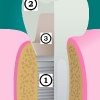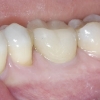If you are confused about what goes on top of a dental implant after it is placed, you are not alone. Questions like: how many components are there? what is an abutment? how does the crown fit into it all? what kind of abutment and crown will be placed?
And the question: Do you really need to worry about all of these?
The answer is ABSOLUTELY YES.
The fact is not all abutments and crowns are created equal. Typically, following the placement of a dental implant, patients must return to their restorative dentist to have the final abutment and crown made. The type and shape of the abutment and crown is critical in achieving longevity and success with the aesthetic and functional results you expect. But far too often, poor abutment and crown designs lead to compromised results and unhappy patients. For best results, make sure your restorative dentist uses a customized abutment for your dental implant. Let’s first review some basics:
A dental implant-supported tooth is made of three parts:
- The dental implant: This is the foundation which supports the overlying abutment and crown.
- The crown: This is the actual tooth that you see.
- The abutment: The abutment is attached to the implant and supports the overlying crown.
There are two types of abutments: Custom and stock (pre-fabricated.)
- Custom abutments are made by a dental laboratory. The restorative dentist captures the position of the implant and the shape of the surrounding gum tissue by taking an impression. The laboratory then fabricates an abutment that resembles the emergence and shape of a natural tooth. The custom abutment will fit perfectly on the implant and supports the gum tissue similar to a natural tooth.
- Stock abutments are manufactured by dental implant companies. Although such pre-fabricated abutments fit well into the implant, they rarely offer proper shape and form. The results are often over-contoured or under-contoured abutments that do not shape the gum tissue properly and create a very unnatural appearance of the crown. Patients often complain of poor aesthetics, ‘dark’ margins, and difficulty with cleaning them.
What should you do as a patient?
- Ask your dentist what type of abutment is planned. Make sure that they give you a custom abutment. This is simply done by taking an impression of your dental implant and sending it to a laboratory to be processed. A low cost dental implant deal may be a good indication that stock abutments are being used instead of custom abutments, as pre-fabricated stock abutments are less costly to the dentist.
- Ask what type of crown they are making. Depending on the area of the mouth and location of the implant, you have choices of all ceramic crowns vs. porcelain-fused to metal crowns. In the smile zone, all ceramic abutments and crowns are more commonly used, while in back of the mouth, titanium abutments with porcelain-fused to metal crowns generally work quite well.
Check out this photo gallery for examples:
A question often asked by some clinicians when planning for dental implants, is whether to use a prefabricated abutment or custom abutments. Some clinicians use prefabricated abutments to lower cost and eliminate the time required for custom impression. The fact is prefabricated abutments are very limited in their use and are inappropriate for most sites. This is because they do not provide the proper support, emergence, profile, and contour for the restoration. As the result, patients often complain of unaesthetic crowns and problems with frequent food impaction. It is recommended to always use custom abutments which consistently provide better results.
Dr. Benjamin Watkins, a renowned Washington DC prosthodontis, says: “In the esthetic zone, the use of custom abutments is an absolute must. There is no better way to create acceptable subgingival contour that matches that of a natural tooth. In addition you cannot adequately control the position of the margin with a stock abutment, which place you at higher risk of trapping cement subgingivally. This a silent but potentially catastrophic issue because once it is there it is often very difficult to remove it and may times the clinician may not be aware that this has occurred until many months after the restoration has been placed.”
He adds: “The long-term implications of subgingival margin placement and inadequate cement removal can lead to complications such as soft tissue inflammation, gingival recession, esthetic failure, loss of peri-implant hard tissue and depending on the proximity of the implant to tooth distance could lead to bone loss on the adjacent teeth. The risk factors of using a stock abutment far outweigh the financial saving gained by using them in any area of the oral cavity.”
In addition to selecting a custom abutment, restorative dentist should pay close attention to clinical requirements and appropriate contours of the restoration to achieve the desired result. They must precisely assess the size of the space, occlusal table, relationship to opposing arch, soft tissue thickness and position of the implant, and guide the laboratory technician with fabricating the right custom abutment and restoration. This can be communicated with study models, photos, specific instructions on contour requirements, and dimensions of the restoration.
The result is a restoration that is aligned with adjacent teeth, well-supported soft tissue, better aesthetic outcome, and teeth that can be easily maintained clean by the patient.
To achieve highly aesthetic, functional, and hygienic dental implant restorations, the following are required:
- Adequate bone width and height
- Adequate soft tissue thickness
- Proper implant width
- Precision implant position, angle, and depth
- An abutment that follows natural tooth anatomy at the gingival interface
- A crown that has proper contour and marginal integrity following the emergency of the abutment
- Proper anatomy of the abutment and crown at the embrasure space to support the papilla
While prefabricated abutments may be cheaper and quicker to do, they rarely provide the type of results that patients expect. Custom abutments are the option of choice for all dental implant restorations. lets look at the following examples:


























